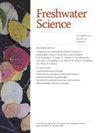Water availability and quality determine temporal synchrony and beta diversity of microcrustaceans in temporary pools
IF 1.6
4区 环境科学与生态学
Q3 ECOLOGY
引用次数: 1
Abstract
Beta diversity patterns have been frequently used to investigate metacommunity structure. The metacommunity concept has focused primarily on the spatial beta component, but part of the unaccounted variation is likely associated with temporal beta patterns. Here, we examined the effect of seasonal variation in water availability on the spatiotemporal assembly of microcrustaceans living in temporary pools. Specifically, we sampled microcrustaceans in 5 pools monthly for 12 mo and tested how temporal fluctuations in physicochemical variables affected beta diversity. We also investigated whether species showed synchronous responses in tracking dry or wet conditions. Our study revealed that only those microcrustacean species associated with the wet season had temporally synchronous population dynamics. However, we did not find population synchrony in the dry season and in those comparisons including all microcrustacean species. Physicochemical variables such as pH, dissolved oxygen, and water transparency explained part of the spatial variation in beta diversity. These results suggest a strong influence of species sorting on metacommunity structure both in space and in time. Extreme climatic conditions, such as water scarcity, could affect population dynamics; thus, linking spatial and temporal patterns will be necessary to disentangle the effects of stochastic processes and environmental filtering on metacommunity dynamics.水的可用性和水质决定了临时水池中微甲壳类动物的时间同步性和β多样性
Beta多样性模式经常被用来研究元群落结构。元群落概念主要关注空间β成分,但部分未解释的变化可能与时间β模式有关。在此,我们研究了季节可用水变化对生活在临时水池中的微甲壳类动物时空聚集的影响。具体来说,我们每月在5个池中取样12个月的微甲壳类动物,并测试了物理化学变量的时间波动如何影响β多样性。我们还研究了物种在干燥或潮湿条件下是否表现出同步反应。研究表明,只有与雨季相关的微甲壳类物种具有时间同步的种群动态。然而,在旱季和所有小甲壳类动物的比较中,我们没有发现种群同步。物理化学变量,如pH值、溶解氧和水透明度,部分解释了β多样性的空间变化。这些结果表明,物种分选对元群落结构在空间和时间上都有很强的影响。极端气候条件,如缺水,可能影响人口动态;因此,有必要将空间和时间模式联系起来,以解开随机过程和环境过滤对元群落动态的影响。
本文章由计算机程序翻译,如有差异,请以英文原文为准。
求助全文
约1分钟内获得全文
求助全文
来源期刊

Freshwater Science
ECOLOGY-MARINE & FRESHWATER BIOLOGY
CiteScore
4.10
自引率
0.00%
发文量
49
审稿时长
6-12 weeks
期刊介绍:
Freshwater Science (FWS) publishes articles that advance understanding and environmental stewardship of all types of inland aquatic ecosystems (lakes, rivers, streams, reservoirs, subterranean, and estuaries) and ecosystems at the interface between aquatic and terrestrial habitats (wetlands, riparian areas, and floodplains). The journal regularly features papers on a wide range of topics, including physical, chemical, and biological properties of lentic and lotic habitats; ecosystem processes; structure and dynamics of populations, communities, and ecosystems; ecology, systematics, and genetics of freshwater organisms, from bacteria to vertebrates; linkages between freshwater and other ecosystems and between freshwater ecology and other aquatic sciences; bioassessment, conservation, and restoration; environmental management; and new or novel methods for basic or applied research.
 求助内容:
求助内容: 应助结果提醒方式:
应助结果提醒方式:


